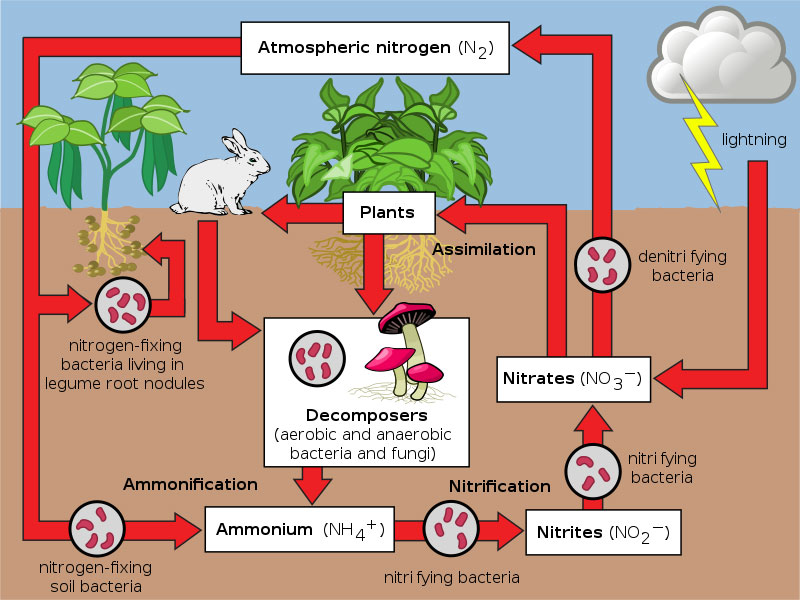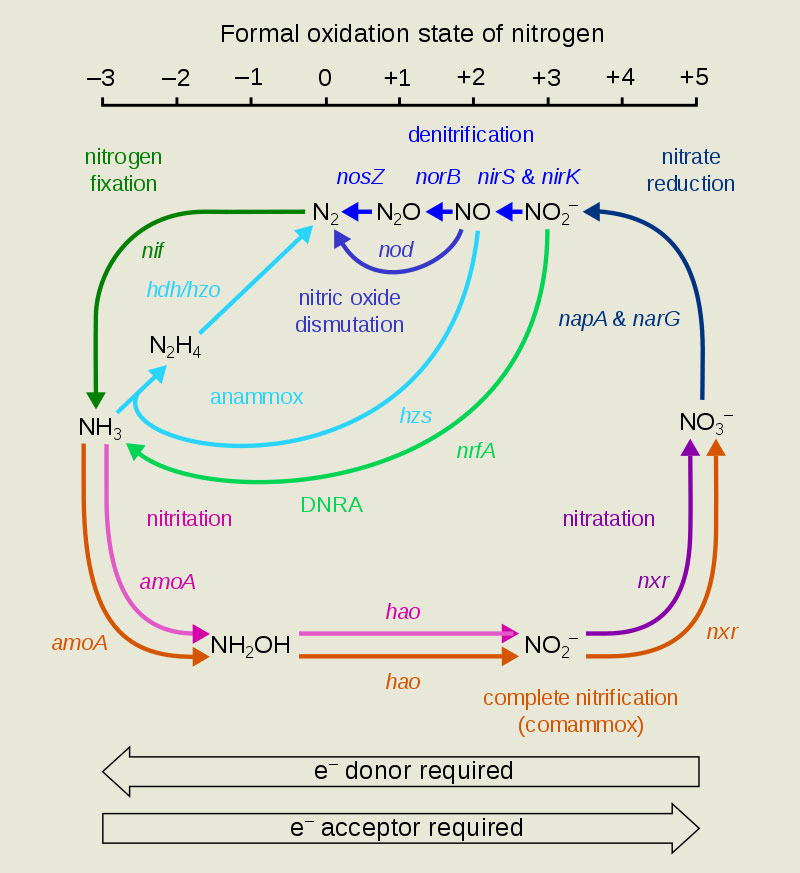


The nitrogen cycle is essential for maintaining the balance of nitrogen in ecosystems, ensuring that living organisms have access to an adequate nitrogen supply while preventing excess nitrogen pollution in the environment, which can lead to water pollution and other ecological problems. Human activities, such as the use of synthetic fertilizers and the burning of fossil fuels, have disrupted the natural nitrogen cycle, contributing to environmental issues like eutrophication and greenhouse gas emissions. Efforts are made to manage and mitigate these impacts through sustainable agricultural practices and environmental conservation measures.
The nitrogen cycle is a crucial biogeochemical process that describes how nitrogen is transformed and circulated through various components of the Earth's ecosystem. Nitrogen is an essential element for all living organisms because it is a key component of amino acids, nucleic acids (DNA and RNA), and proteins. The nitrogen cycle consists of several interconnected steps, each involving different forms of nitrogen and various microorganisms and environmental factors. Here are the main steps in the nitrogen cycle:
In short, the nitrogen cycle is the biogeochemical cycle that describes the transformation of nitrogen through living organisms and the non-living environment. Nitrogen is essential for all living organisms as it is a component of amino acids, nucleotides, and proteins.
The nitrogen cycle is divided into five main steps:
Ammonification is the process by which bacteria or fungi convert organic nitrogen in dead plants and animals into ammonium (NH4+). Ammonium is a form of inorganic nitrogen that can be used by plants and other organisms.
The enzymes involved in ammonification are:

In some environments, such as oxygen-depleted sediments, a unique process called anammox occurs. Specialized bacteria perform anaerobic ammonium oxidation, converting ammonium (NH4+) and nitrite (NO2-) into nitrogen gas (N2) and water (H2O).
Here are some of the ways that humans are affecting the nitrogen cycle:
Fertilizer use: Fertilizers are a major source of nitrogen pollution. When fertilizers are applied to soil, some of the nitrogen is not taken up by plants and can run off into waterways or leach into groundwater. This can lead to algal blooms and eutrophication.
Burning of fossil fuels: When fossil fuels are burned, nitrogen oxides are released into the atmosphere. These nitrogen oxides can contribute to smog and acid rain.
Deforestation: When forests are cleared, the soil loses its ability to hold nitrogen. This can lead to nitrogen leaching and runoff.
There are a number of things that can be done to reduce the impact of human activities on the nitrogen cycle. These include:
Using less fertilizer: Fertilizer use can be reduced by using more efficient irrigation methods and by planting cover crops.
Switching to low-nitrogen fertilizers: There are a number of low-nitrogen fertilizers available that can be used to reduce nitrogen pollution.
Recycling nitrogen: Nitrogen can be recycled by using wastewater treatment plants to remove nitrogen from wastewater and using it to grow crops.
Protecting forests: Forests play an important role in the nitrogen cycle by storing nitrogen in the soil. Protecting forests can help to reduce nitrogen leaching and runoff.
The nitrogen cycle is a complex process that is essential for life on Earth. However, human activities are affecting the nitrogen cycle in a number of ways. By taking steps to reduce our impact on the nitrogen cycle, we can help to protect the environment and ensure that nitrogen is available for future generations.
Use cover crops: Cover crops are plants that are grown between cash crops. They help to improve soil health by suppressing weeds, reducing erosion, and increasing soil organic matter. Cover crops can also fix nitrogen from the atmosphere, which can help to reduce the need for fertilizer.
Rotate crops: Crop rotation is the practice of planting different crops in the same field in a planned sequence. This helps to reduce the build-up of pests and diseases, and it can also help to improve soil health.
Use compost: Compost is a mixture of organic materials that has been decomposed by microorganisms. It can be used to improve soil fertility and structure, and it can also help to reduce the need for fertilizer. You can find more on organic compost and manure here.
Practice integrated pest management (IPM): IPM is a system of pest control that uses a variety of methods to manage pests. This can include biological control, cultural control, and chemical control. IPM helps to reduce the use of pesticides, which can pollute the environment and harm beneficial organisms. You can find more on Integrated Pest Management here.
Use water wisely: Water is a precious resource, and it is important to use it wisely in agriculture. This can be done by using drip irrigation, which delivers water directly to the roots of plants, and by planting drought-tolerant crops.
Protect soil health: Soil health is essential for sustainable agriculture. It can be protected by practices such as cover cropping, crop rotation, and no-till farming.
By following these practices, farmers can help to protect the nitrogen cycle and ensure that it continues to function for future generations.
In addition to these practices, there are a number of other things that can be done to help the nitrogen cycle in sustainable farming. These include:
Use less synthetic fertilizer: Synthetic fertilizers can pollute the environment and harm beneficial organisms. Farmers can reduce their reliance on synthetic fertilizers by using organic fertilizers, such as compost, and by practicing crop rotation.
Manage manure properly: Manure is a valuable source of nutrients, but it can also pollute the environment if it is not managed properly. Farmers can manage manure properly by storing it in a secure location and by applying it to the soil at the correct time and rate.
Educate farmers about the nitrogen cycle: Farmers need to be aware of the importance of the nitrogen cycle and how their practices can affect it. Farmers can be educated about the nitrogen cycle through workshops, training programs, and other resources.
By taking these steps, farmers can help to protect the nitrogen cycle and ensure that it continues to function for future generations.
